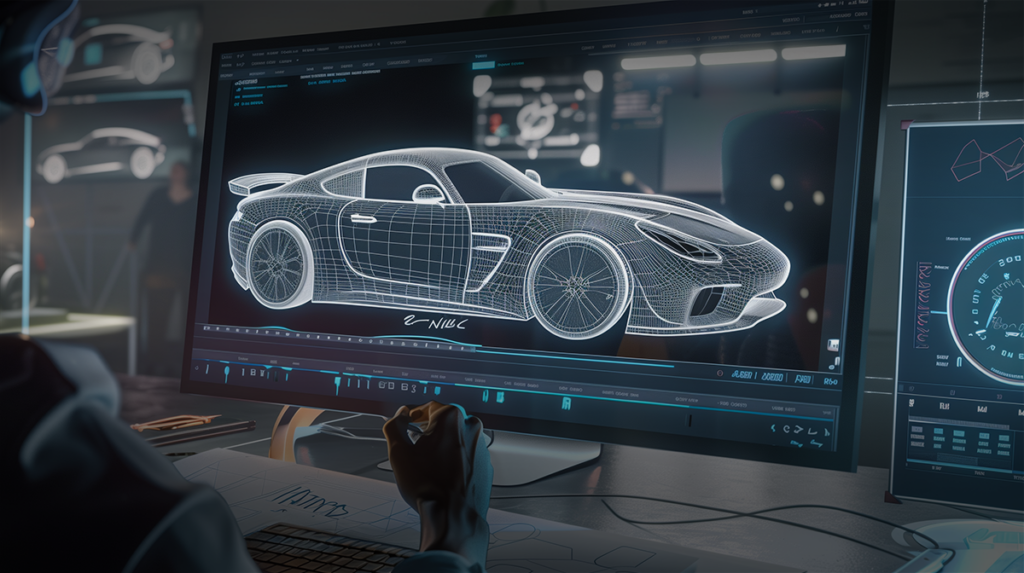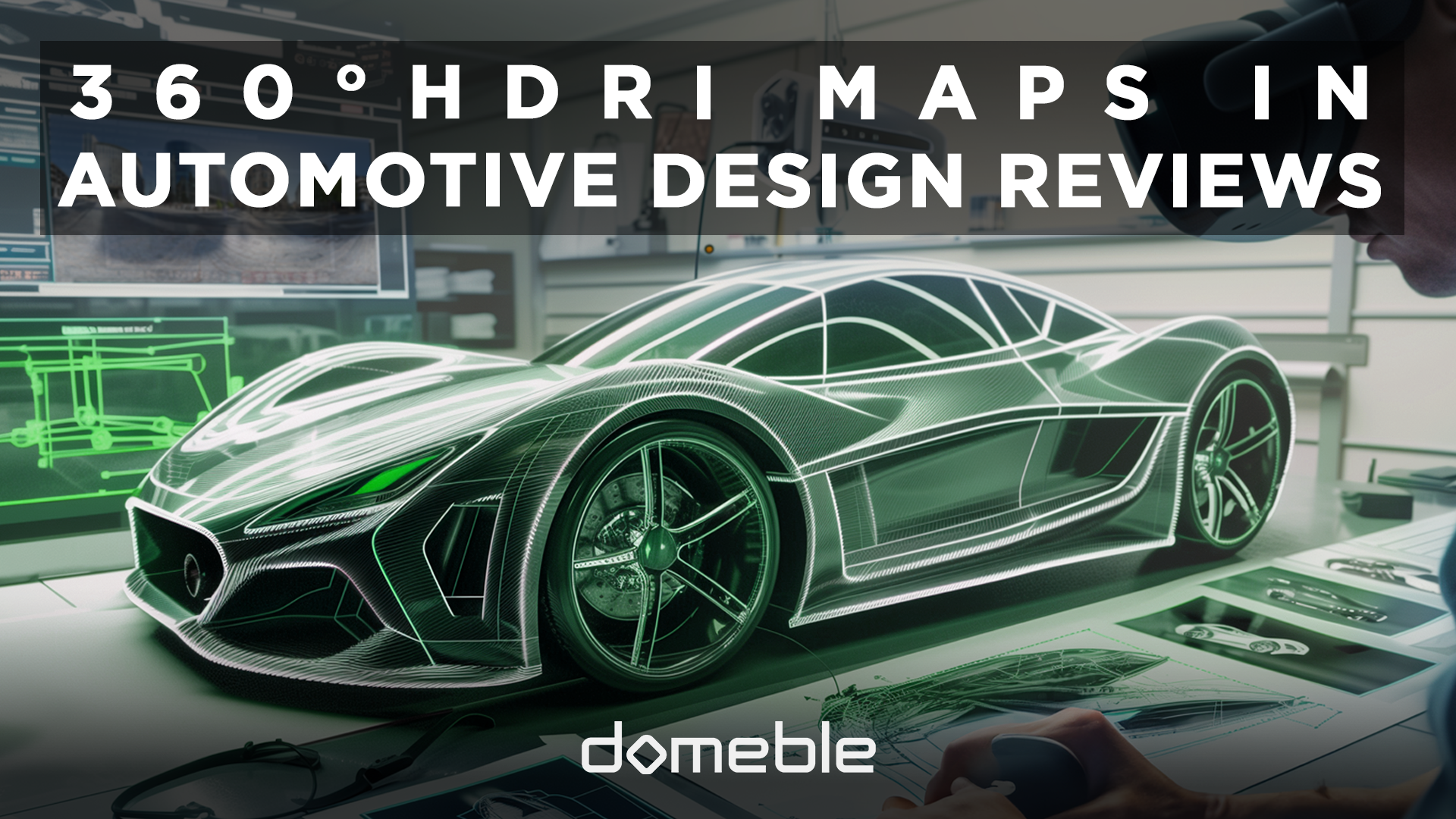For those of us in the industry, we often take for granted the processes that start as a pencil sketch on the back of a notepad and ends up as a physically beautiful object that gets us from A to B. We often get asked by people, what is a design review, and how does Domeble fit into the process, so we thought we’d open the door of the design review process.
Automotive design reviews consist of critical iteration stages in the evolution of a vehicle, where creativity meets scrutiny, and dreams are honed into reality. These reviews are not merely checkpoints; they are dynamic sessions involving designers, engineers, and key stakeholders who collaborate to perfect a vehicle’s design. Its not all hi level tech, but there is a a heavy dependence on very clever pieces of software, and of course specialised imagery including 360 HDRI (High Dynamic Range Imaging) technology, which is where Domeble come in.
The Journey from Sketch to Reality
The automotive design process begins with the spark of an idea, often sketched out by visionary designers. These initial sketches are more than just drawings; they are the conceptual seeds that will grow into a fully realised vehicle. Designers iterate on these sketches, refining the concept until it’s ready to transition into digital renderings.
The digital renderings are the process that the sketches to life, providing a more detailed and realistic representation of the design. At this stage, designers can play with proportions, materials, and colours, making crucial adjustments before the design moves to the next phase: visualisation.
The Role of Visualisation in Design Reviews
Visualisation is where 360 HDRI technology comes into play, utilising Domeble’s high resolution, super dynamic content. The high-quality HDRI maps are used to create virtual environments that mimic real-world lighting conditions with stunning accuracy. These maps capture the full range of light intensity in a scene, from the brightest highlights to the deepest shadows, providing a comprehensive lighting solution for digital models.
Using HDRI maps from Domeble, automotive design teams can place their digital renderings into a variety of real-world settings. Whether it’s a bustling urban street or a serene rural landscape, these environments help designers and stakeholders see how the vehicle will look and perform in different lighting, terrain and environment conditions.
The Power of 360 HDRI in Design Reviews
Design reviews are highly visual processes. Stakeholders need to see the vehicle from every angle, understand how light interacts with its surfaces, and assess its overall aesthetic and functional appeal. This is where the power of 360 HDRI becomes evident.
High-resolution 360 HDRI maps provide a level of detail that static images simply can’t match, particularly with the Domeble maps at over 30,000 pixels in resolution. They allow for a full panoramic view, ensuring that every aspect of the design is visible and can be evaluated accurately. This immersive experience is crucial for making informed decisions about the design.
But the benefits of 360 HDRI maps extend beyond mere visualisation. In today’s competitive market, speed is essential. Designers need to iterate quickly, and having high-quality HDRI maps means they can test different lighting scenarios in real-time. This rapid iteration helps speed up the design process, reducing time-to-market substantially compared to even just 2 or 3 years ago.

Enhancing Design Reviews with VR
The integration of Virtual Reality (VR) takes design reviews to the next level. By combining 360 HDRI maps with VR technology, designers can create immersive experiences that allow stakeholders to virtually step into the vehicle’s environment. This provides a deeper understanding of the design, offering insights that are impossible to gain from flat images or even 3D models on a screen.
In a VR setting, stakeholders (who can be located on every corner of the planet) can explore the vehicle’s interior and exterior, experiencing it as if it were already built. They can see how different lighting conditions affect the look and feel of the vehicle, providing a more comprehensive evaluation of the design. Domeble’s HDRI maps are particularly well-suited for this purpose, offering the high resolution and detail necessary to make these VR experiences truly lifelike.
Technical Excellence in HDRI Maps
The quality and resolution of HDRI maps are critical in shaping the design review process. High-quality HDRI maps capture a wide range of lighting information, ensuring that every reflection, shadow, and highlight is accurately represented. This level of detail is essential for making precise adjustments to the design, and why Domeble 360 HDRI maps are so well used in this process.
Domeble’s HDRI maps stand out for their technical excellence. Each map is crafted with meticulous attention to detail, capturing the full dynamic range of lighting in various environments ( find out more here). This allows designers to simulate how the vehicle will look in different real-world settings, providing a reliable basis for decision-making.
For instance, designers can evaluate how a car’s paint job looks under different lighting conditions, ensuring that the colour remains vibrant and true to the intended design. They can also assess how different materials reflect light, making informed choices about finishes and textures on both exterior and interior designs.
The Collaborative Advantage
Design reviews are inherently collaborative. They bring together diverse perspectives, from the creative vision of designers to the technical expertise of engineers. 360 HDRI maps facilitate this collaboration by providing a common visual reference that everyone can understand.
By using high-quality HDRI maps, teams can communicate more effectively, ensuring that everyone is on the same page. This reduces misunderstandings and helps streamline the design process, ultimately leading to better outcomes.
Shaping the Future with HDRI
In the fast-evolving world of automotive design, 360 HDRI technology is a game-changer. It enhances every stage of the design review process, from initial sketches to final prototypes. By providing realistic lighting environments and supporting VR experiences, HDRI maps enable designers to create vehicles that are not only visually stunning but also highly functional.
Domeble’s commitment to innovation and quality ensures that their HDRI maps are the best tools for this purpose. As the automotive industry continues to embrace digital transformation, the role of 360 HDRI technology will only grow, driving innovation and shaping the future of automotive design.
By leveraging the power of 360 HDRI maps, automotive designers can push the boundaries of what’s possible, creating the next generation of vehicles that will captivate consumers and set new standards for the industry. Should you want to know more contact us at info@domeble.com or try out our free samples here.










